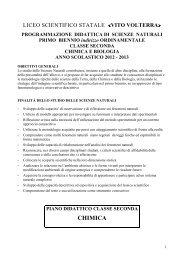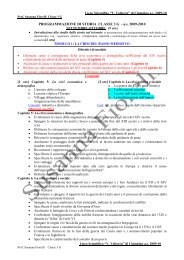Tesina - Liceo Scientifico Statale Vito Volterra
Tesina - Liceo Scientifico Statale Vito Volterra
Tesina - Liceo Scientifico Statale Vito Volterra
You also want an ePaper? Increase the reach of your titles
YUMPU automatically turns print PDFs into web optimized ePapers that Google loves.
Blake's "Newton" is a demonstration of his opposition to the "singlevision"<br />
of scientific materialism: The great philosopher-scientist is<br />
isolated in the depths of the ocean, his eyes (only one of which is<br />
visible) fixed on the compasses with which he draws on a scroll. He<br />
seems almost at one with the rocks upon which he sits (1795).<br />
Later life and career<br />
Blake's "A Negro Hung Alive by the Ribs to a Gallows", an<br />
illustration to J. G. Stedman's Narrative, of a Five Years' Expedition,<br />
against the Revolted Negroes of Surinam (1796).<br />
Blake's marriage to Catherine remained a close and devoted one<br />
until his death. There were early problems, however, such as<br />
Catherine's illiteracy and the couple's failure to produce children.<br />
Gilchrist refers to "stormy times" in the early years of the marriage [8]<br />
It is possible that at one point, in accordance with the beliefs of the<br />
Swedenborgian Society, Blake suggested bringing in a concubine. [9]<br />
Catherine was distressed at the idea, and Blake promptly withdrew it.<br />
Blake taught her to write, and she helped him to colour his printed poems. [10]<br />
Around the year 1800 Blake moved to a cottage at Felpham in Sussex (now West Sussex) to take<br />
up a job illustrating the works of William Hayley, a minor poet. It was in this cottage that Blake<br />
wrote Milton: a Poem (published between 1805 and 1808). The preface to this work includes a<br />
poem beginning "And did those feet in ancient time", which became the words for the patriotic<br />
song, "Jerusalem". Over time, Blake came to resent his new patron, coming to believe that Hayley<br />
was not paying as well as he could afford to pay.<br />
Blake returned to London in 1802 and began to write and illustrate Jerusalem (1804–1820), his<br />
most ambitious work. Having conceived the idea of portraying the characters in Chaucer's<br />
Canterbury Pilgrims, Blake approached the dealer Robert Cromek, with a view to marketing an<br />
engraving. Knowing that Blake was too eccentric to produce a popular work, Cromek promptly<br />
commissioned Thomas Stothard to execute the concept. When Blake learned that he had been<br />
cheated, he broke off contact with Stothard, formerly a friend. He also set up an independent<br />
exhibition in his brother's shop, designed to market his own version of the Chaucer illustraton,<br />
along with other works. As a result he wrote his Descriptive Catalogue (1809), which contains what<br />
Anthony Blunt has called a "brilliant analysis" of Chaucer. It is regularly anthologised as a classic<br />
of Chaucer criticism. [11] It also contained detailed explanations of his other paintings.<br />
He was introduced by George Cumberland to a young artist named John Linnell. Through<br />
Linnell he met Samuel Palmer, who belonged to a group of artists who called themselves the<br />
Shoreham Ancients. This group shared Blake's rejection of modern trends and his belief in a<br />
spiritual and artistic New Age. At the age of 65 Blake began work on illustrations for the Book of<br />
Job. These works were later admired by John Ruskin, who compared Blake favourably to<br />
Rembrandt.<br />
Blake abhorred slavery and believed in racial and sexual equality [12] . Several of his poems and<br />
paintings express a notion of universal humanity: "As all men are alike (tho' infinitely various)". He<br />
retained an active interest in social and political events for all his life, but was often forced to resort<br />
to cloaking social idealism and political statements in Protestant mystical allegory.<br />
He rejected all forms of imposed authority; indeed, he was charged with assault and uttering<br />
seditious and treasonable expressions against the King in 1803, though he later was cleared in the<br />
40


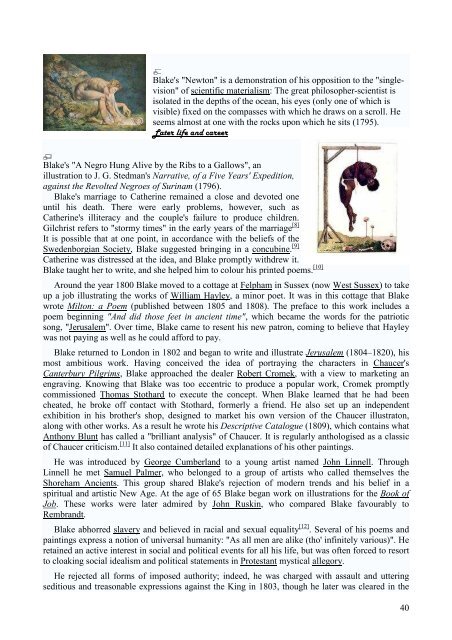
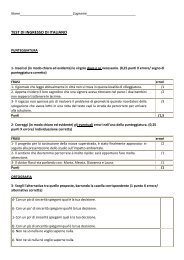
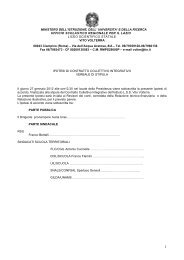
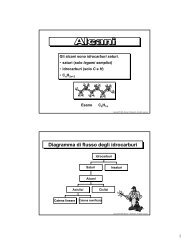


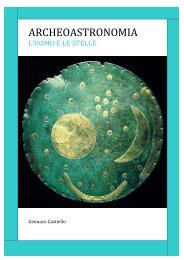

![SETTEMBRE – NOVEMBRE [20 ore] - Liceo Scientifico Statale Vito ...](https://img.yumpu.com/16098766/1/184x260/settembre-novembre-20-ore-liceo-scientifico-statale-vito-.jpg?quality=85)


